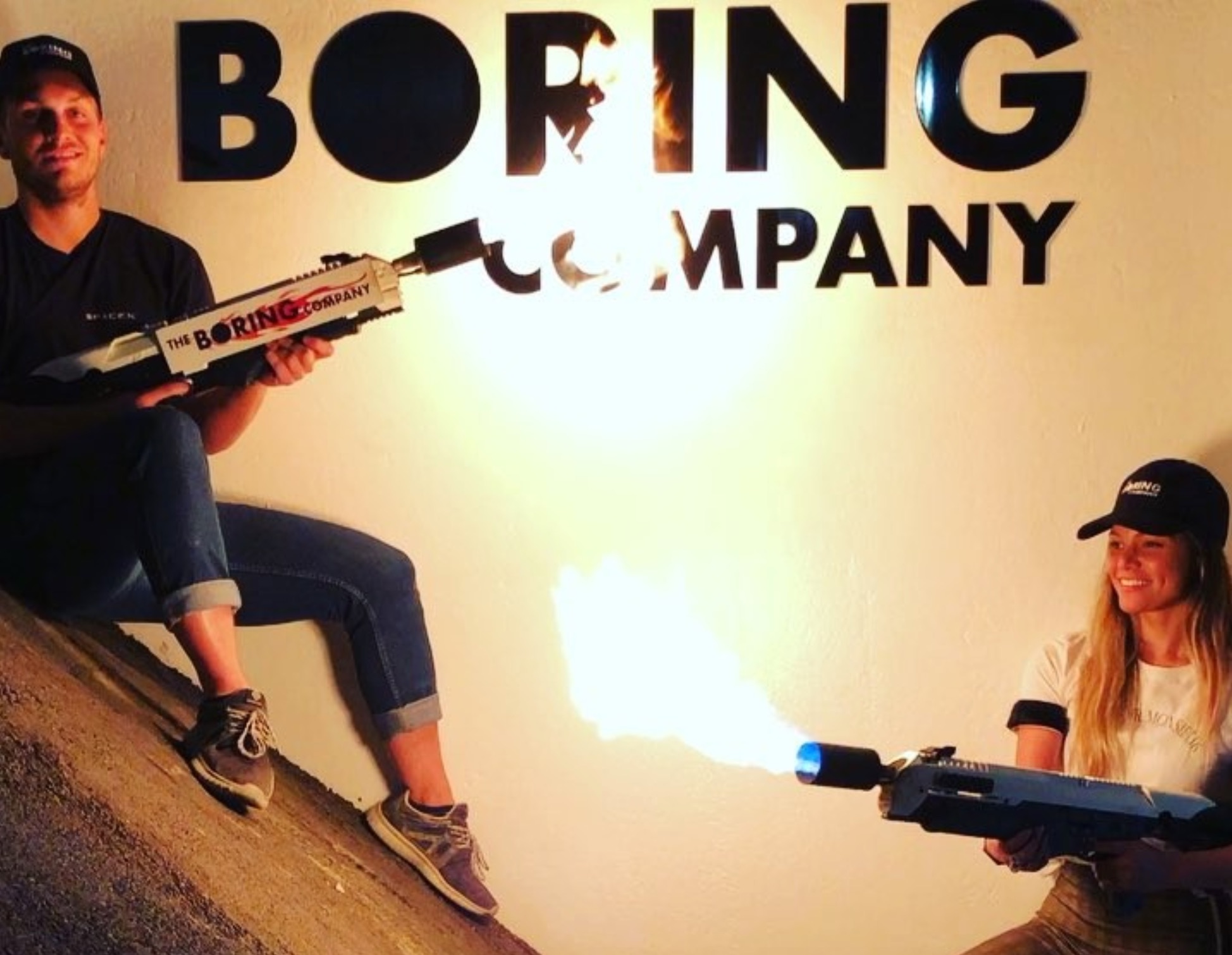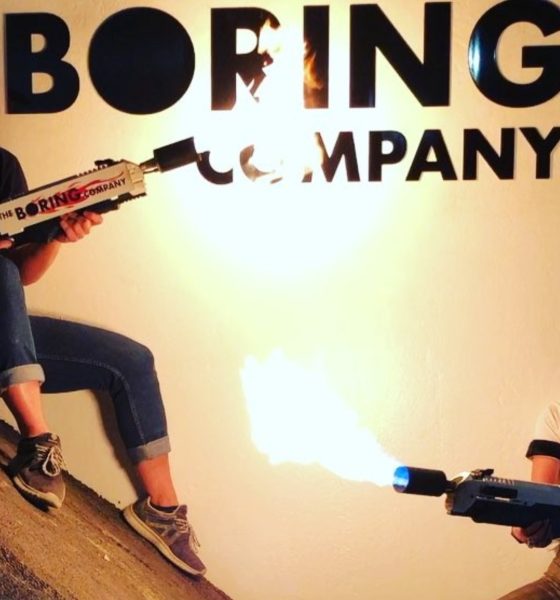

News
The Boring Co. is holding a Not-a-Flamethrower pickup party on June 9
In an update on Saturday, Elon Musk announced that The Boring Company would be holding a Not-a-Flamethrower pickup party in Los Angeles on June 9.
During The Boring Company’s information session earlier this month, Elon Musk, together with SpaceX engineer Steve Davis, stated that the delivery and shipment of the Not-a-Flamethrowers were delayed since shipping items with propane proved to be complicated. Thus, according to Musk, the Boring Co. has come up with a solution to its shipping problems — the company will custom-deliver the Not-a-Flamethrowers to the homes of reservation holders.
About to ship. @BoringCompany holding flamethrower pickup parties in a week or so, then deliveries begin. Check https://t.co/WTl3TOTOkt for details.
— Elon Musk (@elonmusk) May 26, 2018
As it turns out, however, the Boring Company has an extra surprise before it starts delivering the fiery device. As could be seen in a recently shared screenshot of a correspondence from the tunneling startup (credit to u/Herbrax212 of the r/BoringCompany subreddit), a pick-up party for the first 1,000 Not-a-Flamethrowers would be held in Los Angeles on June 9. Following is an excerpt from the email that The Boring Company recently sent out to reservation holders.
Anyways… we are hosting a Not-a-Flamethrower pickup party in Los Angeles on June 9, 2018, from noon to 5 pm. Up to 1,000 customers can pick up their Not-a-Flamethrower, toast some marshmallows, take some fun pics, prep to take on a zombie horde, and (of course) receive a refund for their shipping charges. Only eligible customers who have signed the terms and conditions and have registered at www.boringcompany.com/pickup may attend. Don’t worry if you can’t make it; all Not-a-Flamethrowers will ship out this summer!
Where should we throw our next pick up party?
The Boring Company
The Boring Company Not-a-Flamethrower started off as a joke from Elon Musk and yet another reference to Hollywood sci-fi flick Spaceballs. In a tweet last December, Musk stated that the tunneling startup would release a flamethrower after selling its 50,000th Boring Company hat. Sure enough, after the inventory of the hats were cleared out, signs of the Boring Company Flamethrower started emerging.
By January, musician D.A. Wallach shared a video of the fiery device on his Instagram page. Not long after that, Elon Musk officially launched the Flamethrower in the Boring Company’s website, selling the contraption for $500 each. All 20,000 Boring Company Flamethrowers were sold out within four days, raising $10 million for the tunneling startup.
The device, however, did not come without its detractors. California assemblyman Miguel Santiago (D-Los Angeles), for one, expressed his opposition to the device, citing its safety concerns. Customs agencies also stated that they would not ship anything that is branded as a flamethrower. In response to this, Musk opted to rebrand the fiery device, calling it a Not-a-Flamethrower.
While the Boring Company Not-a-Flamethrower looks like a powerful firestarter, the device is actually more akin to a propane torch fitted on what appears to be a modified airsoft rifle. Considering that the device can only shoot flames up to a few feet, the Not-a-Flamethrower is actually more similar to a Weed Dragon, which could be purchased in any hardware store, than an actual flamethrower such as the XM42-M, which can shoot flames up to 30 feet.

News
Tesla FSD fleet is nearing 7 billion total miles, including 2.5 billion city miles
As can be seen on Tesla’s official FSD webpage, vehicles equipped with the system have now navigated over 6.99 billion miles.

Tesla’s Full Self-Driving (Supervised) fleet is closing in on almost 7 billion total miles driven, as per data posted by the company on its official FSD webpage.
These figures hint at the massive scale of data fueling Tesla’s rapid FSD improvements, which have been quite notable as of late.
FSD mileage milestones
As can be seen on Tesla’s official FSD webpage, vehicles equipped with the system have now navigated over 6.99 billion miles. Tesla owner and avid FSD tester Whole Mars Catalog also shared a screenshot indicating that from the nearly 7 billion miles traveled by the FSD fleet, more than 2.5 billion miles were driven inside cities.
City miles are particularly valuable for complex urban scenarios like unprotected turns, pedestrian interactions, and traffic lights. This is also the difference-maker for FSD, as only complex solutions, such as Waymo’s self-driving taxis, operate similarly on inner-city streets. And even then, incidents such as the San Francisco blackouts have proven challenging for sensor-rich vehicles like Waymos.
Tesla’s data edge
Tesla has a number of advantages in the autonomous vehicle sector, one of which is the size of its fleet and the number of vehicles training FSD on real-world roads. Tesla’s nearly 7 billion FSD miles then allow the company to roll out updates that make its vehicles behave like they are being driven by experienced drivers, even if they are operating on their own.
So notable are Tesla’s improvements to FSD that NVIDIA Director of Robotics Jim Fan, after experiencing FSD v14, noted that the system is the first AI that passes what he described as a “Physical Turing Test.”
“Despite knowing exactly how robot learning works, I still find it magical watching the steering wheel turn by itself. First it feels surreal, next it becomes routine. Then, like the smartphone, taking it away actively hurts. This is how humanity gets rewired and glued to god-like technologies,” Fan wrote in a post on X.
News
Tesla starts showing how FSD will change lives in Europe
Local officials tested the system on narrow country roads and were impressed by FSD’s smooth, human-like driving, with some calling the service a game-changer for everyday life in areas that are far from urban centers.

Tesla has launched Europe’s first public shuttle service using Full Self-Driving (Supervised) in the rural Eifelkreis Bitburg-Prüm region of Germany, demonstrating how the technology can restore independence and mobility for people who struggle with limited transport options.
Local officials tested the system on narrow country roads and were impressed by FSD’s smooth, human-like driving, with some calling the service a game-changer for everyday life in areas that are far from urban centers.
Officials see real impact on rural residents
Arzfeld Mayor Johannes Kuhl and District Administrator Andreas Kruppert personally tested the Tesla shuttle service. This allowed them to see just how well FSD navigated winding lanes and rural roads confidently. Kruppert said, “Autonomous driving sounds like science fiction to many, but we simply see here that it works totally well in rural regions too.” Kuhl, for his part, also noted that FSD “feels like a very experienced driver.”
The pilot complements the area’s “Citizen Bus” program, which provides on-demand rides for elderly residents who can no longer drive themselves. Tesla Europe shared a video of a demonstration of the service, highlighting how FSD gives people their freedom back, even in places where public transport is not as prevalent.
What the Ministry for Economic Affairs and Transport says
Rhineland-Palatinate’s Minister Daniela Schmitt supported the project, praising the collaboration that made this “first of its kind in Europe” possible. As per the ministry, the rural rollout for the service shows FSD’s potential beyond major cities, and it delivers tangible benefits like grocery runs, doctor visits, and social connections for isolated residents.
“Reliable and flexible mobility is especially vital in rural areas. With the launch of a shuttle service using self-driving vehicles (FSD supervised) by Tesla in the Eifelkreis Bitburg-Prüm, an innovative pilot project is now getting underway that complements local community bus services. It is the first project of its kind in Europe.
“The result is a real gain for rural mobility: greater accessibility, more flexibility and tangible benefits for everyday life. A strong signal for innovation, cooperation and future-oriented mobility beyond urban centers,” the ministry wrote in a LinkedIn post.
News
Tesla China quietly posts Robotaxi-related job listing
Tesla China is currently seeking a Low Voltage Electrical Engineer to work on circuit board design for the company’s autonomous vehicles.

Tesla has posted a new job listing in Shanghai explicitly tied to its Robotaxi program, fueling speculation that the company is preparing to launch its dedicated autonomous ride-hailing service in China.
As noted in the listing, Tesla China is currently seeking a Low Voltage Electrical Engineer to work on circuit board design for the company’s autonomous vehicles.
Robotaxi-specific role
The listing, which was shared on social media platform X by industry watcher @tslaming, suggested that Tesla China is looking to fill the role urgently. The job listing itself specifically mentions that the person hired for the role will be working on the Low Voltage Hardware team, which would design the circuit boards that would serve as the nervous system of the Robotaxi.
Key tasks for the role, as indicated in the job listing, include collaboration with PCB layout, firmware, mechanical, program management, and validation teams, among other responsibilities. The role is based in Shanghai.
China Robotaxi launch
China represents a massive potential market for robotaxis, with its dense urban centers and supportive policies in select cities. Tesla has limited permission to roll out FSD in the country, though despite this, its vehicles have been hailed as among the best in the market when it comes to autonomous features. So far, at least, it appears that China supports Tesla’s FSD and Robotaxi rollout.
This was hinted at in November, when Tesla brought the Cybercab to the 8th China International Import Expo (CIIE) in Shanghai, marking the first time that the autonomous two-seater was brought to the Asia-Pacific region. The vehicle, despite not having a release date in China, received a significant amount of interest among the event’s attendees.








